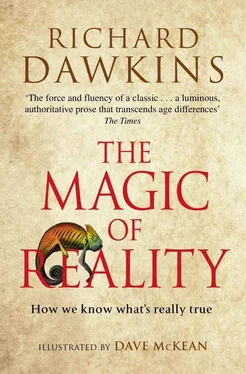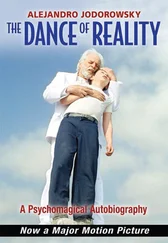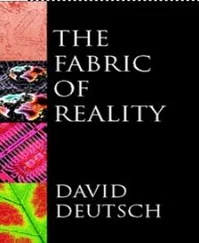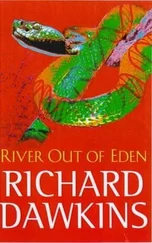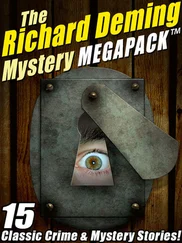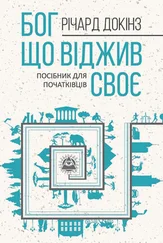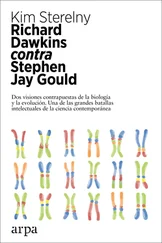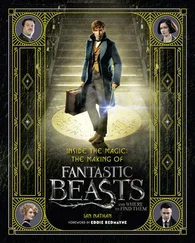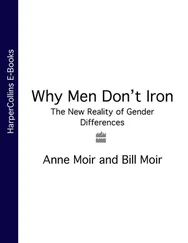Here’s an example. Nowadays, we know that genes – the units of heredity – are made of stuff called DNA. We know a great deal about DNA and how it works. But you can’t see the details of what DNA looks like, even with a powerful microscope. Almost everything we know about DNA comes indirectly from dreaming up models and then testing them.
Actually, long before anyone had even heard of DNA, scientists already knew lots about genes from testing the predictions of models. Back in the nineteenth century, an Austrian monk called Gregor Mendel did experiments in his monastery garden, breeding peas in large quantities. He counted the numbers of plants that had flowers of various colours, or that had peas that were wrinkly or smooth, as the generations went by. Mendel never saw or touched a gene. All he saw were peas and flowers, and he could use his eyes to count different types. He invented a model , which involved what we would now call genes (though Mendel didn’t call them that), and he calculated that, if his model were correct, in a particular breeding experiment there ought to be three times as many smooth peas as wrinkly ones. And that is what he found when he counted them. Leaving aside the details, the point is that Mendel’s ‘genes’ were an invention of his imagination: he couldn’t see them with his eyes, not even with a microscope. But he could see smooth and wrinkled peas, and by counting them he found indirect evidence that his model of heredity was a good representation of something in the real world. Later scientists used a modification of Mendel’s method, working with other living things such as fruit flies instead of peas, to show that genes are strung out in a definite order, along threads called chromosomes (we humans have forty-six chromosomes, fruit flies have eight). It was even possible to work out, by testing models, the exact order in which genes were arranged along chromosomes. All this was done long before we knew that genes were made of DNA.
Nowadays we know this, and we know exactly how DNA works, thanks to James Watson and Francis Crick, plus a lot of other scientists who came after them. Watson and Crick could not see DNA with their own eyes. Once again, they made their discoveries by imagining models and testing them. In their case, they literally built metal and cardboard models of what DNA might look like, and they calculated what certain measurements ought to be if those models were correct. The predictions of one model, the so-called double helix model, exactly fitted the measurements made by Rosalind Franklin and Maurice Wilkins, using special instruments involving X-rays beamed into crystals of purified DNA. Watson and Crick also immediately realized that their model of the structure of DNA would produce exactly the kind of results seen by Gregor Mendel in his monastery garden.
We come to know what is real, then, in one of three ways. We can detect it directly, using our five senses; or indirectly, using our senses aided by special instruments such as telescopes and microscopes; or even more indirectly, by creating models of what might be real and then testing those models to see whether they successfully predict things that we can see (or hear, etc.), with or without the aid of instruments. Ultimately, it always comes back to our senses, one way or another.
Does this mean that reality only contains things that can be detected, directly or indirectly, by our senses and by the methods of science? What about things like jealousy and joy, happiness and love? Are these not also real?
Yes, they are real. But they depend for their existence on brains: human brains, certainly, and probably the brains of other advanced animal species, such as chimpanzees, dogs and whales, too. Rocks don’t feel joy or jealousy, and mountains do not love. These emotions are intensely real to those who experience them, but they didn’t exist before brains did. It is possible that emotions like these – and perhaps other emotions that we can’t begin to dream of – could exist on other planets, but only if those planets also contain brains – or something equivalent to brains: for who knows what weird thinking organs or feeling machines may lurk elsewhere in the universe?
Science and the supernatural: explanation and its enemy
So that is reality, and that is how we can know whether something is real or not. Each chapter of this book is going to be about one particular aspect of reality – the sun, for instance, or earthquakes, or rainbows, or the many different kinds of animals. I want now to turn to the other key word of my title: magic. Magic is a slippery word: it is commonly used in three different ways, and the first thing I must do is distinguish between them. I’ll call the first one ‘supernatural magic’, the second one ‘stage magic’ and the third one (which is my favourite meaning, and the one I intend in my title) ‘poetic magic’.
Supernatural magic is the kind of magic we find in myths and fairy tales. (In ‘miracles’, too, though I shall leave those to one side for now and return to them in the final chapter.) It’s the magic of Aladdin’s lamp, of wizards’ spells, of the Brothers Grimm, of Hans Christian Andersen and of J. K. Rowling. It’s the fictional magic of a witch casting a spell and turning a prince into a frog, or a fairy godmother changing a pumpkin into a gleaming coach. These are the stories we all remember with fondness from our childhood, and many of us still enjoy when served up in a traditional Christmas pantomime – but we all know this kind of magic is just fiction and does not happen in reality.
Stage magic, by contrast, really does happen, and it can be great fun. Or at least, something really happens, though it isn’t what the audience thinks it is. A man on a stage (it usually is a man, for some reason) deceives us into thinking that something astonishing has happened (it may even seem supernatural) when what really happened was something quite different. Silk handkerchiefs cannot turn into rabbits, any more than frogs can turn into princes. What we have seen on the stage is only a trick. Our eyes have deceived us – or rather, the conjuror has gone to great pains to deceive our eyes, perhaps by cleverly using words to distract us from what he is really doing with his hands.
Some conjurors are honest and go out of their way to make sure their audiences know that they have simply performed a trick. I am thinking of people like James ‘The Amazing’ Randi, or Penn and Teller, or Derren Brown. Even though these admirable performers don’t usually tell the audience exactly how they did the trick – they could be thrown out of the Magic Circle (the conjurors’ club) if they did that – they do make sure the audience knows that there was no supernatural magic involved. Others don’t actively spell out that it was just a trick, but they don’t make exaggerated claims about what they have done either – they just leave the audience with the rather enjoyable sensation that something mysterious has happened, without actively lying about it. But unfortunately there are some conjurors who are deliberately dishonest, and who pretend they really do have ‘super-natural’ or ‘paranormal’ powers: perhaps they claim that they really can bend metal or stop clocks by the power of thought alone. Some of these dishonest fakes (‘charlatans’ is a good word for them) earn large fees from mining or oil companies by claiming that they can tell, using ‘psychic powers’, where would be a good place to drill. Other charlatans exploit people who are grieving, by claiming to be able to make contact with the dead. When this happens it is no longer just fun or entertainment, but preying on people’s gullibility and distress. To be fair, it may be that not all of these people are charlatans. Some of them may sincerely believe they are talking to the dead.
Читать дальше
